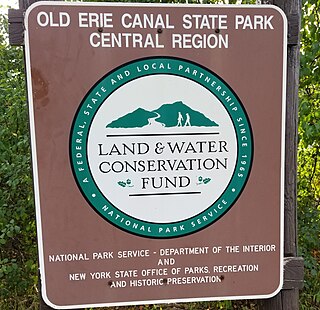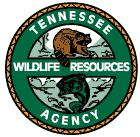
National Wildlife RefugeSystem (NWRS) is a system of protected areas of the United States managed by the United States Fish and Wildlife Service (FWS), an agency within the Department of the Interior. The National Wildlife Refuge System is the system of public lands and waters set aside to conserve America's fish, wildlife, and plants. Since President Theodore Roosevelt designated Florida's Pelican Island National Wildlife Refuge as the first wildlife refuge in 1903, the system has grown to over 568 national wildlife refuges and 38 wetland management districts encompassing about 856,000,000 acres (3,464,109 km2).

The Federal Duck Stamp, formally known as the Migratory Bird Hunting and Conservation Stamp, is an adhesive stamp issued by the United States federal government that must be purchased prior to hunting for migratory waterfowl such as ducks and geese. It is also used to gain entrance to National Wildlife Refuges that normally charge for admission. It is widely seen as a collectable and a means to raise funds for wetland conservation, with 98% of the proceeds of each sale going to the Migratory Bird Conservation Fund.

The National Wildlife Federation (NWF) is the United States' largest private, nonprofit conservation education and advocacy organization, with over six million members and supporters, and 51 state and territorial affiliated organizations (including Puerto Rico and the Virgin Islands).
Catoosa Wildlife Management Area is a large game-management area on the Upper Cumberland Plateau in Morgan, Cumberland and Fentress counties in Tennessee in the United States. It comprises 96,000 acres (332 km2) of wild land administered by the Tennessee Wildlife Resources Agency (TWRA). The Management Area is funded by hunters and fishermen, and is popular with all outdoors enthusiasts, including backpackers, and whitewater rafters. It has many trails for hiking, of which the most notable is the Cumberland Trail. It also has gravel roads and dirt track four-wheel drive roads for motorized exploration. Catoosa ranges from gentle rolling hills to some of the most rugged and extreme terrain in the country. Many rivers and streams have cut deep canyons into the Cumberland Plateau and Cumberland Mountains of the Management area allowing for beautiful vistas.

The Kentucky Department of Fish and Wildlife Resources, an agency of the Kentucky Tourism, Arts and Heritage Cabinet, is responsible for the conservation of wildlife resources and for boating projects in the state. A commissioner appointed by the Fish and Wildlife Commission heads the department. The commission—which oversees the department's commissioner and promulgates regulations governing fishing, hunting, and boating—is a nine-member bipartisan board appointed by the governor from a list of candidates nominated by active hunters and anglers in each of nine geographic districts in the state.

The National Wildlife Refuge System in the United States has a long and distinguished history.

The Michigan Department of Natural Resources (DNR) is the agency of the state of Michigan founded in 1921, charged with maintaining natural resources such as state parks, state forests, and recreation areas. It is governed by a director appointed by the Governor and accepted by the Natural Resources Commission. Since 2023, the Director is Scott Bowen. The DNR has about 1,400 permanent employees, and over 1,600 seasonal employees.

The Arizona Game and Fish Department is a state agency of Arizona, headquartered in Phoenix. The agency is tasked with conserving, enhancing, and restoring Arizona's diverse wildlife resources and habitats through protection and management programs.

The United States' Land and Water Conservation Fund (LWCF) is a federal program that was established by Act of Congress in 1965 to provide funds and matching grants to federal, state and local governments for the acquisition of land and water, and easements on land and water, for the benefit of all Americans. The main emphases of the fund are recreation and the protection of national natural treasures in the forms of parks and protected forest and wildlife areas. The LWCF has a broad-based coalition of support and oversight, including the National Parks Conservation Association, Environment America, The Wilderness Society, the Land Trust Alliance, the Nature Conservancy, the National Wildlife Federation, and The Conservation Fund.

The Tennessee Wildlife Resources Agency (TWRA) is an independent state agency of the state of Tennessee with the mission of managing the state's fish and wildlife and their habitats, as well as responsibility for all wildlife-related law enforcement activities. The agency also has responsibility for fostering the safe use of the state's waters through a program of law enforcement, education, and access.

The Rocky Mountain Elk Foundation (RMEF) is a conservation and pro-hunting organization, founded in the United States in 1984 by four hunters from Troy, Montana. Its mission is to ensure the future of elk, other wildlife, their habitat and American hunting heritage. In support of this mission the RMEF is committed to:
- Conserving, restoring, and enhancing natural habitats;
- Promoting the sound management of wild, free-ranging elk, which may be hunted or otherwise enjoyed;
- Fostering cooperation among federal, state, tribal, and private organizations and individuals in wildlife management and habitat conservation; and
- Educating members and the public about habitat conservation, the value of hunting, hunting ethics, and wildlife management.

According to the California Protected Areas Database (CPAD), in the state of California, United States, there are over 14,000 inventoried protected areas administered by public agencies and non-profits. In addition, there are private conservation areas and other easements. They include almost one-third of California's scenic coastline, including coastal wetlands, estuaries, beaches, and dune systems. The California State Parks system alone has 270 units and covers 1.3 million acres (5,300 km2), with over 280 miles (450 km) of coastline, 625 miles (1,006 km) of lake and river frontage, nearly 18,000 campsites, and 3,000 miles (5,000 km) of hiking, biking, and equestrian trails.

Pheasants Forever, Inc. (PF), a 501(c)(3) non-profit conservation organization, is dedicated to conserving wildlife habitat suitable for pheasants. Formed in 1982 as a response to the continuing decline of upland wildlife and habitat throughout the United States, Pheasants Forever, and its quail conservation division, Quail Forever, have a combined membership of approximately 150,000 throughout North America.

Turkey hunting is a sport involving the pursuit of the elusive wild turkey. Long before the European settlers arrived in North America, the Native Americans took part in hunting wild turkeys.
The U.S. Sportsmen's Alliance is a non-profit organization based in Columbus, Ohio, United States, that was formed in 1977. The Alliance defends the rights of hunters, anglers, trappers, and sport shooters.
The Federal Aid in Wildlife Restoration Act of 1937, most often referred to as the Pittman–Robertson Act for its sponsors, Nevada Senator Key Pittman and Virginia Congressman Absalom Willis Robertson, is an act that imposes an 11% tax on firearms, ammunition, and archery equipment and distributes the proceeds to state governments for wildlife projects.

The Summer Lake Wildlife Area is a 29.6-square-mile (77 km2) wildlife refuge located on the northwestern edge of the Great Basin drainage in south-central Oregon. It is administered by the Oregon Department of Fish and Wildlife. The refuge is an important stop for waterfowl traveling along the Pacific Flyway during their spring and fall migrations. The Summer Lake Wildlife Area also provides habitat for shorebirds and other bird species as well as wide variety of mammals and several fish species. The Ana River supplies the water for the refuge wetlands.

American Prairie is a prairie-based nature reserve in Central Montana, United States, on a mixed grass prairie ecosystem with migration corridors and native wildlife. This wildlife conservation area is being developed as a private project of the American Prairie Foundation (APF). This independent non-profit organization aims to include over 3 million acres (12,000 km2) through a combination of both private and public lands.
The North American Model of Wildlife Conservation is a set of principles that has guided wildlife management and conservation decisions in the United States and Canada. Although not formally articulated until 2001, the model has its origins in 19th century conservation movements, the near extinction of several species of wildlife and the rise of sportsmen with the middle class. Beginning in the 1860s sportsmen began to organize and advocate for the preservation of wilderness areas and wildlife. The North American Model of Wildlife Conservation rests on two basic principles – fish and wildlife are for the non-commercial use of citizens, and should be managed such that they are available at optimum population levels forever.

Big Woods Wildlife Management Area is a 4,173-acre (16.89 km2) Wildlife Management Area (WMA) in Sussex County, Virginia. It comprises two tracts of land; the 2,208-acre (8.94 km2) main tract, located immediately adjacent Big Woods State Forest, and the 1,965-acre (7.95 km2) Parker's Branch tract, located nearby.
















